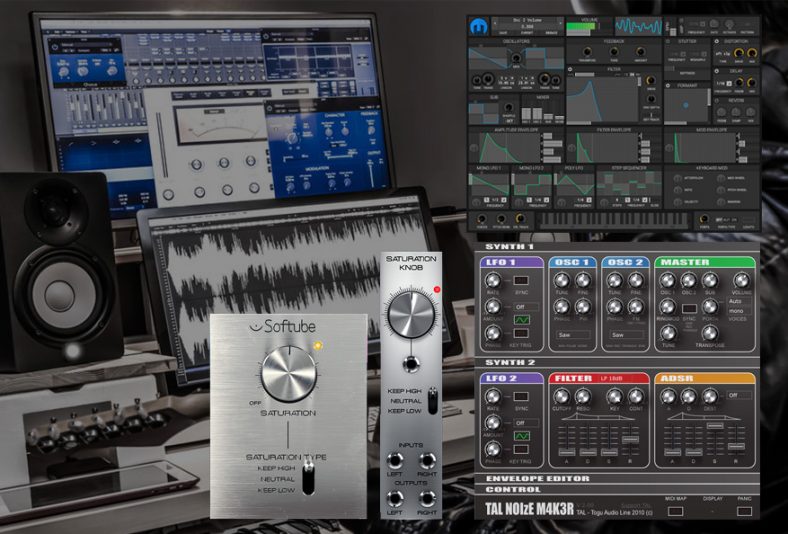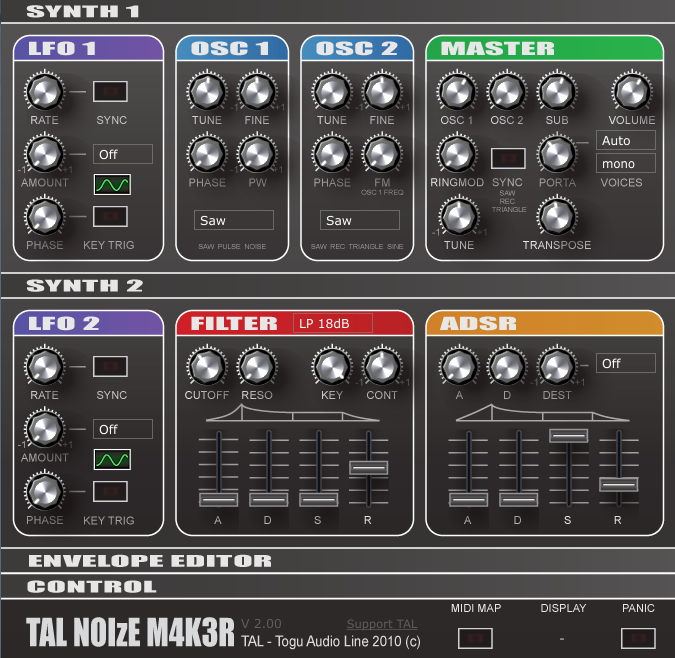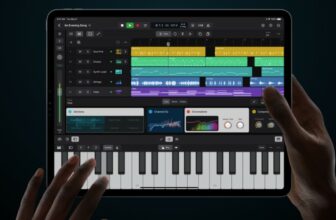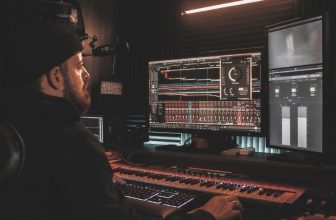What are VST Plugins? (And How to Use Them)

VST (Virtual Studio Technology) Plugins act as an extension to your digital audio workstation (DAW). They can be in the form of Virtual Instruments (e.g. Synths, Drum Machines), Effects (e.g. Distortion, Reverb), or MIDI effects.
Virtual Studio Technology or “VST” is a software standard that extends the functionality of your Digital Audio Workstation (DAW). Examples of DAWs are Ableton Live, Cubase, or Reaper.
VSTs can range from completely free to very expensive!
Plugins usually come with a custom graphical user interface, featuring knobs, sliders, and buttons which can be adjusted like with hardware. They also have the ability to load and save presets of settings for easy recall.
Many VST plugins emulate (or digitally replicate) the look, sound, and functions of classic hardware units that otherwise might be too expensive or difficult to obtain.
These hardware emulations are designed to look like the original hardware they are based on. They feature similar controls and parameters.
Contents
For example, Native Instruments, Plugin Boutique, Waves, Slate Digital, and numerous other brands make plug-in versions of classic hardware like the UREI 1176 Compressor, the Neve 1073 preamp, and more.
Different Types of VST Plugins
#1 VST Instruments
VST Instruments or VSTi are plugins are essentially software samplers or synthesizers, which produce sound when given MIDI notes as input in real-time. Modern VSTi plugins can emulate pianos, synths, drum kits, guitars, or even entire orchestras.
As an example of a free VST instrument plugin, you can look at TAL-NoiseMaker. It is a versatile and highly customizable synthesizer plugin:

Over the years, this technology has developed to a point where they can do this with an astonishing degree of accuracy.
There are thousands of such plugins that may be specialized (just one instrument) or generic (a bunch of instruments like all woodwinds). Their cost, functionality, and complexity can vary to a great extent.
Related articles:
Plugins for Vocals
Best Guitar VST Plugins
Best Vocoder Plugins
Best Free Orchestral Plugins
#2 VST Effects
Unlike VSTi, VST Effects or VSTfx do not generate any sound or audio by themselves.
Instead, they are used to change the characteristics of existing audio by applying effects to them like reverb, delay, chorus, compression, EQ, etc.
Softube’s Saturation Knob is a great example of a simple but effective VST Effects plugin, it adds punch and pleasant harmonics to drums, vocals or brings fullness to mix when desired.
VST Effects work in a similar way to adding a reverb or delay pedal to your guitar rig to add the desired fx (effect) to your source tone – the guitar sound.
Just like these delay pedals, many classic and legendary hardware effect units have been digitally reproduced down to the component level through VSTfx technology.
This also including classic amplifiers, preamps and plugins that emulate microphones.
VST plugins allow for ‘chaining’, that is, one VST plugin can pass on audio to another VST for further processing.
So, a VSTi for a piano can pass on the sound it generates to a VSTfx saturator for processing, which can further be run through VSTfx for delay and so on.
#3 VST MIDI Effects
MIDI refers to Musical Instrument Digital Interface. Simplistically speaking, a VST instrument can create audio when MIDI data is sent from your computer (DAW like FL Studio 20 or Logic Pro X) to the MIDI controller (a MIDI Keyboard).
VST instruments exchange data with your DAW when they are loaded on a MIDI track. These MIDI instruments can be generated and manipulated using an external MIDI controller.
VST MIDI Effects are used to accept MIDI information signals such as transpose, triggers, or arpeggios and pass them on to other VSTs or hardware units.
For example, an arpeggiator plugin might accept MIDI notes as input and interpret it as step sequenced arpeggio patterns to be played with a VSTi.
The MIDI protocol can use multiple VST plugins that can communicate with each other. We’ve written an article about this and the soon to be launched MIDI 2.0 technology that might interest you.
Related:
VSTs vs AUs and AAX (Mac)
Not all DAWs use VST Plugins. There are other formats!
While VST remains a popular standard across DAWs and OS platforms, other brands have also developed other proprietary plugin standards for use with their DAWs or audio engines.
Apple introduced Audio Units (AU) to work with their Core Audio engine on Mac systems. Avid introduced Real-Time Audio Suite (RTAS), and later Avid Audio eXtension (AAX) plugins to use with their Pro Tools DAW.
The information below uses the VST terminology, but the functionality is present across all the other mentioned standards.
Let us look at the various times of plugins, how to use them and some of the current favorites among music producers and recording artists.
How to use VST plugins in your DAW
All modern DAWs provide comprehensive integration of VST (or any proprietary equivalent) plugins within their interfaces.
Plugins can be used as ‘inserts’ or ‘sends’, in keeping up with the vocab used in hardware effects routing. In practice, this simply means putting an instance of the plugin onto an audio or MIDI track.
Multiple plugins can be chained on a single track to achieve varied step-wise processing. The same plugin can also be used multiple times.
The number of plugins one could use simultaneously in real-time is practically only limited by their computer’s processing capabilities. This provides a vast advantage over hardware units and allows for surgical precision and flexibility.
Celemony and PreSonus’ new standard extension Audio Random Access (ARA), allows for even deeper integration between plugins and the DAW, like passing on pitch, tempo, or chord information for an entire session at once.
Installing Plugins
It’s very easy to install audio plugins on your DAW, check out the following articles for more information. A similar process to this would be used for all other DAWs:
- Garageband – Free Plugins and How to Install Them
- VST Plugins in Ableton Live (How to Install, Free VSTs for Ableton)
Some popular free VST plugins
There are thousands of both free and paid VST plugins on the market for a plethora of uses. If you’re just getting started and want to try out some great VSTs without breaking the bank, here’s a list of some excellent free plugins to explore:
1. Plugin Boutique TAL Noise Maker

A super versatile free synth, shipping with 128 professionally designed presets, and featuring inbuilt modules for reverb, delay, chorus, and bit crushing.
2. Native Instruments Komplete Start
From the makers of Kontakt, the world’s most powerful sampling engine, Komplete Start is an incredible free collection of over 2000 sounds including synths, world-class instrument libraries, and effects.
It also includes numerous loops and NI’s Guitar Rig 6 Player, featuring simulations of several legendary amplifiers and cabinets.
3. Tytel Helm
Another great free synthesizer, with a built-in step sequencer, and controls for stutter, formant adjustment, and more.
Helm is also completely open-source, meaning that you are free to study and change the source code to tweak the plugin if you’re interested in the programming behind VSTs.
4. Valhalla DSP Freq Echo
Valhalla DSP has garnered a reputation amongst top industry professionals for their superb reverb plugins like Valhalla Plate and valhalla vintage verb, and their Freq Echo plugin, provided completely free of cost, is no less.
Freq Echo enables you to create dreamy, psychedelic sounds with just about any source. Experimentation is truly rewarding with this creative effect plugin.
5. Softube Saturation Knob
Featuring a sleek and super simple UI consisting of a single large knob and a switch, this is one of those plugins that can magically make sound anything better just by putting it on.
It features 3 different frequency-dependent distortion modes and brings a taste of the much-coveted warm analog character to any source you use it on.
Plugin Bundles
In the course of music production, you will inevitably find yourself in need of multiple tools for various functions. Compressors, EQs, reverbs, delays, etc. are the bread and butter of production, and you will need to acquire specialized tools i.e. plugins for each of these processes.
Rather than spend hours and a significant amount of money in selecting every individual plugin from amidst the thousands on offer, it is a good idea to invest in plugin bundles.
A plugin bundle by a specific manufacturer features a collection of their plugins covering a wide range of functions, meant to be a one-stop solution to cover all essential production aspects.
Plugin bundles usually cost less than buying each of the plugins individually.
They also provide design and functional consistency across the products and save a lot of time otherwise spent in the searching process. This way you can focus on the music more instead of collecting tools.
Some popular plugin bundles include Izotope Music Production Suite 3, Native Instruments Komplete 12 Ultimate, and Soundtoys 5.
Find out more about these in our article on the best plugin bundles.
Don’t Overdo it With Plugins (Especially at the start)
A pitfall that many music producers and musicians run into early on when they start out, is that they start hoarding plugins and getting more plugins then they could possibly ever need.
Plugins should not be used to cover up for a lack of knowledge of sound production and music production.
Many digital audio workstations already include great quality internal plugins that are efficient and have a wide variety of sound.
For example, Ableton Live’s operator, analog, and wavetable plugins are 3 great quality. Don’t be fooled by their simple interfaces!
You can get even better results from these synthesizers than you could from some other external VST plugins and they will often perform a lot better on your computer.
So I would suggest that you try to master the internal stock plugins of your DAW, and when you start to really understand and know all about them, then you can start to plug in extra VSTs separately, which will enhance your workflow and improve the sound possibilities.
As much as we absolutely love the sound possibilities that VST plugins give, just getting a bunch of plugins off the bat, while not understanding them, can actually hinder your growth in the future as a music producer.
Difference Between VST and VSTi Plugins
VSTi Plugins are a specific type of VST plugins that are used to create sounds. Synths plugins, sampler plugins, and drum machine plugins are all examples of VSTi plugins. VST Plugins is the general term for all types of ‘Virtual Studio Technology’ plugins, which include VST Instruments, Effects, and MIDI plugins.
Conclusion
VST plugins enable us to leverage the technology of digital signal processing to achieve very detailed and powerful audio processing, which in the analog age would have been very expensive and physically limiting.
Although certain hardware units are still used for their characteristic sonic signature, most major studios and producers around the world have shifted to a hybrid model, consisting of both software and hardware processing.
For home studios, independent musicians, and producers, plugins have made it possible to achieve very polished results using only a personal computer at affordable costs. We hope this article helps you understand the basics of VST plugins and our recommendations free plugins can help you get started.






